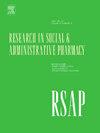Practical naloxone communication tips for pharmacists: Lessons learned from the Linguistic Model of Patient Participation in Care
IF 3.7
3区 医学
Q1 PUBLIC, ENVIRONMENTAL & OCCUPATIONAL HEALTH
Research in Social & Administrative Pharmacy
Pub Date : 2025-01-27
DOI:10.1016/j.sapharm.2025.01.014
引用次数: 0
Abstract
Background
Opioid overdose is an ongoing public health issue in the rural United States and can be countered by increasing access to the opioid antagonist naloxone. Community pharmacists are well-positioned to offer and dispense naloxone to patients at risk of opioid overdose, but still experience a range of communication barriers. Understanding rural patient communication preferences is essential to prepare pharmacists to discuss naloxone in a patient-centered manner.
Objective
To explore rural community pharmacists' and patients’ naloxone communication preferences employing the Linguistic Model of Patient Participation in Care (LM).
Methods
In-depth qualitative interviews were conducted with 40 community pharmacists and 40 patients from rural areas in Alabama, Iowa, North Carolina, and Wisconsin. After a thematic analysis of the interview transcripts, three code reports were selected for a secondary qualitative analysis informed by the LM.
Results
All elements described in the LM (Predisposing Factors, Enabling Factors, And Provider's Communication Style) were associated with patient-pharmacist naloxone communication. The analysis revealed four additional factors not accounted for in the model: Stigma, Privacy, Insurance Coverage and Price, and Collaboration with Physician.
Conclusion
Patient-pharmacist naloxone conversations are impacted by the factors described in the LM, as well as several pharmacy-specific factors which were included in an adapted conceptual model. Future studies should consider these findings when developing interventions to improve patient-pharmacist communication and pharmacists can utilize the practical tips provided to actively address the opioid epidemic.
实用的纳洛酮沟通提示药剂师:从病人参与护理的语言模型中吸取的教训。
背景:阿片类药物过量是美国农村地区一直存在的公共卫生问题,可以通过增加阿片类药物拮抗剂纳洛酮的使用来解决这一问题。社区药剂师完全有能力为有阿片类药物过量风险的患者提供和分配纳洛酮,但他们仍会遇到一系列沟通障碍。了解农村患者的沟通偏好对药剂师以患者为中心讨论纳洛酮至关重要:采用患者参与护理的语言模式(LM),探讨农村社区药剂师和患者的纳洛酮沟通偏好:对来自阿拉巴马州、爱荷华州、北卡罗来纳州和威斯康星州农村地区的 40 名社区药剂师和 40 名患者进行了深入的定性访谈。在对访谈记录进行主题分析后,根据 LM,选择了三个代码报告进行二次定性分析:结果:LM 中描述的所有因素(倾向性因素、有利因素和提供者的沟通风格)都与患者和药剂师之间的纳洛酮沟通有关。分析显示,模型中还有四个因素没有考虑到:结论:结论:患者与药剂师之间的纳洛酮交流受到 LM 中描述的因素以及几个药剂学特定因素的影响,这些因素已被纳入调整后的概念模型中。未来的研究在制定改善患者与药剂师沟通的干预措施时应考虑这些发现,药剂师可以利用所提供的实用技巧积极应对阿片类药物的流行。
本文章由计算机程序翻译,如有差异,请以英文原文为准。
求助全文
约1分钟内获得全文
求助全文
来源期刊

Research in Social & Administrative Pharmacy
PUBLIC, ENVIRONMENTAL & OCCUPATIONAL HEALTH-
CiteScore
7.20
自引率
10.30%
发文量
225
审稿时长
47 days
期刊介绍:
Research in Social and Administrative Pharmacy (RSAP) is a quarterly publication featuring original scientific reports and comprehensive review articles in the social and administrative pharmaceutical sciences. Topics of interest include outcomes evaluation of products, programs, or services; pharmacoepidemiology; medication adherence; direct-to-consumer advertising of prescription medications; disease state management; health systems reform; drug marketing; medication distribution systems such as e-prescribing; web-based pharmaceutical/medical services; drug commerce and re-importation; and health professions workforce issues.
 求助内容:
求助内容: 应助结果提醒方式:
应助结果提醒方式:


